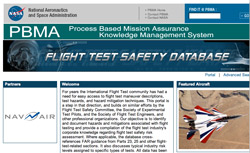NASA and the Federal Aviation Administration have joined forces to develop a Web-based flight test safety database that is envisioned as the aviation test-flying community’s one-stop reference guide to conducting flight tests safely. Officials of both agencies believe the database, which went on-line in mid-April, will become one of the most significant contributions to aviation safety since development of the flight test hazard analysis used by most flight test pilots and engineers.
 Image left: Web page for the Flight Test Safety Database developed by NASA and the Federal Aviation Administration.
Image left: Web page for the Flight Test Safety Database developed by NASA and the Federal Aviation Administration.
NASA’s Office of Safety and Mission Assurance initially funded the effort as a research initiative but was quickly joined by the FAA, which had started its own comparable effort. Both agencies mutually funded the development of a Web site as the primary means of making the data available to the flight test community and have developed teaming arrangements with industry to compile and populate the actual data.
NASA’s Dryden Flight Research Center, Edwards, Calif., had initiated discussion within the flight test safety community on ways to meet mutual needs for easy access to test hazards and mitigation techniques associated with flight test disciplines applicable to both commercial and government research and development testing. Phase one of the effort was to develop FAA aircraft certification flight test safety data covering flight test requirements outlined in Title 14 of the Code of Federal Regulations (CFR) along with their associated hazards, identified risk levels, and mitigating procedures. Data for CFR Title 14 Part 25 aircraft certification maneuvers is now available in the portal.
Bart Henwood, NASA’s database project manager and Dryden’s aviation safety manager, said this effort has been the vision of the flight-test community for years. The database will integrate standard flight test safety practices used by industry and the government in a user-friendly Web-based format.
The Web site allows both civilian and government organizations easy access to valuable safety information that will serve to reduce the risk when flight-testing aircraft. It will eventually serve as a forum for sharing valuable lessons learned from flight tests in order to prevent repetition of close calls, incidents and/or accidents, although specific references to these events will not be part of the database. Located on a NASA Web site, the database is non-regulatory in nature and in the public domain.
The portal interface allows the user the ability to search the data by various parameters as well as keywords resulting in a list of selected records. The user can then choose to print or save these records individually or in a combined format for further manipulation.
“This is a professional’s database and is designed for the use by a trained flight test professional who can apply the data to the actual flight test context – a specific aircraft and specific test objectives,” Henwood emphasized. “As such, the data can be used by test professionals involved at every step of the process from the test manager/director to the test engineer/conductor.”
According to FAA test pilot Rod Huete, flight testing of new and highly modified aircraft has always had inherent hazards and risks, which have produced many accidents and are costly in terms of human lives and material assets lost. These accidents have not been unique to novice test pilots and crews, but have happened to even the most experienced crews.
“Over the years, industry and the government have improved flight test safety by establishing safety programs through application of risk management procedures,” Huete said. “Today, both the government and industry are able to perform flight testing much more efficiently due to these programs. The days of just ‘kick the tire, light the fire’ are essentially gone.”
Unfortunately, many of these safety programs and their associated databases have been only available to the specific organizations or companies that developed them and have not been shared across industry as a whole, Huete added. Many flight test accidents could have been prevented if a general database had been widely available.
“This initiative did not materialize earlier due to the lack of an organization’s commitment in resources and time,” Henwood commented. “Such an effort takes the “higher ground” of preventing accidents over the loss in any one organization’s competitive edge.”
NASA Dryden awarded a contract to the National Test Pilot School in Mojave, Calif., more than a year ago to assist in collection of FAA-related data for the first phase of this initiative. The school has been contacting the various FAA aircraft certification offices and civilian aircraft manufacturers for flight test safety data. Data obtained from industry is reviewed prior to inclusion in the database to protect proprietary interests.
The new flight test safety database Web portal was activated on April 16, 2007, and can be accessed at http://pbma.nasa.gov/ftsdb/Home.aspx
For more information on the Internet about NASA Dryden Flight Research Center and its research projects, visit: https://www.nasa.gov/centers/dryden/home/index.html
For more information on the FAA and its flight safety programs, visit www.faa.gov
– end –
text-only version of this release
To receive status reports and news releases issued from the Dryden Newsroom electronically, send a blank e-mail message to dfrc-subscribe@newsletters.nasa.gov. To unsubscribe, send a blank e-mail message to dfrc-unsubscribe@newsletters.nasa.gov. The system will confirm your request via e-mail.
Dryden Flight Research Center
P.O. Box 273
Edwards, California 93523
Phone 661/276-3449
FAX 661/276-3566
Leslie Williams
NASA Dryden Flight Research Center
661-276-3893
Leslie.A.Williams@nasa.gov
Laura Brown
Federal Aviation Administration, Washington, DC
202-267-3455
laura.brown@faa.gov


























